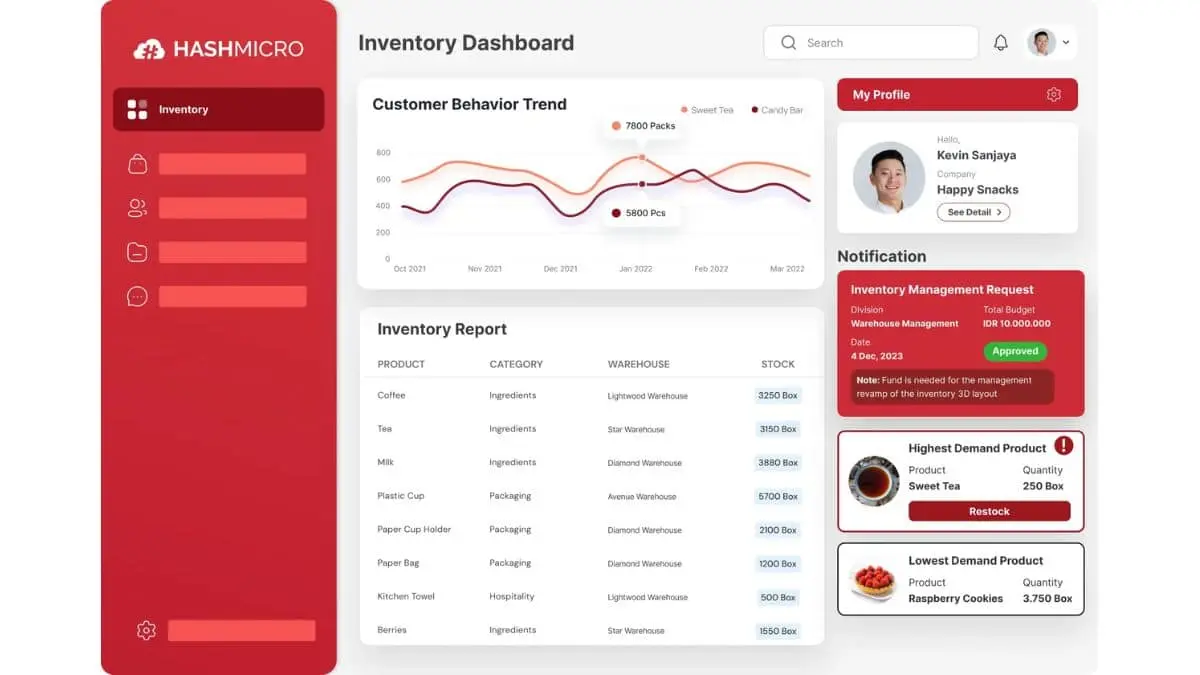Having an optimal amount of stock is important in the inventory business. This has led to the emergence of many ways to optimize stock, one of which is inventory forecasting. But what is inventory forecasting?
Inventory forecasting is the process of predicting the amount of stock items that will be needed in the future based on sales data, market trends, and demand patterns. It works by analyzing historical data and using algorithms to generate accurate forecasts of stock requirements.
Based on the definition’s explanation, inventory forecasting helps companies predict future customer needs. As a result, companies can prepare for customers’ needs without worrying about their needs not being met.
Inventory forecasting has several different types and formulas. Therefore, in this article, we will present in-depth information about inventory forecasting, ranging from its types and benefits to tips for effective implementation for companies.
Ano pa hinihintay mo Pag-usapan natin ito ngayon din!
Table of Contents
Key Takeaways
|
What is Inventory Forecasting?
Inventory forecasting is a process that companies use to estimate the amount of goods needed to meet future demand. By minimizing excess or shortage of inventory, it can optimize stock, reduce storage costs, and improve business operational efficiency.
Demand forecasting is a form of prevention that helps companies prepare the ideal number of stock items to meet customer needs. Now, imagine if you don’t do inventory forecasting and prepare the ideal stock quantity. Then, your customers have needs that need to be met, and you don’t have the ideal stock for them. This incident will have a bad impact on the company.
Slowly, customers with unmet needs will start losing trust in your company. Eventually, this will result in customer loss and decreased profits. Without inventory forecasting, operational efficiency may decrease, and the company may find it difficult to respond to market demand changes promptly.
Inventory forecasting itself consists of historical sales data, seasonal factors, business cycles, and lead times. The combination of these factors helps companies determine when and how many items to order, so as to optimize stock availability and reduce the risk of running out or excess goods.
Multiple Inventory Forecasting Methods
As a process used to prepare future stock quantities, inventory forecasting itself is divided into several methods. Here are some inventory implementation methods that you need to take a closer look at:
1. Graphical forecasting
The application of this method involves visualizing historical data in the form of graphs or diagrams to identify patterns or trends that may not be clearly visible in the raw numbers. Through graph visualization, companies can spot seasonal fluctuations and spikes in demand that may affect inventory decisions.
However, this method also has its limitations, especially if there are no clear trends or if the available data is too variable. In such situations, graphical analysis may need to be supplemented with quantitative or qualitative methods to get a more accurate picture.
2. Trend forecasting
Trend forecasting is a method for identifying emerging patterns or trends. For example, once, there was a trend on social media about an item with a certain engraving. Then, this forecasting method was effective.
However, trend forecasting also has weaknesses, especially in the event of sudden changes that do not match historical trends. For example, an unexpected event such as an economic crisis or a major change in consumer preferences can affect the accuracy of trend forecasting.
3. Quantitative forecasting
Quantitative forecasting is an inventory forecasting method that involves mathematical calculations such as moving averages, exponential smoothing, or regression analysis. Since this inventory forecasting is based on objective data, quantitative forecasting is often considered more accurate and reliable, especially when sufficient historical data is available.
However, this method has limitations in the event of significant changes in market conditions or other external factors that are not reflected in historical data. Therefore, it is important to combine quantitative forecasting with other analyses to get a more complete picture.
4. Qualitative forecasting
Qualitative forecasting relies on the judgment of industry experts, customer surveys, or focus groups to predict future demand. It is often used when historical data is unavailable or unreliable, such as for new products or emerging markets.
Since this method involves judgment rather than objective data, it is vulnerable to bias and subjectivity. Decisions taken based on intuition or personal opinion may not always reflect the broader market reality. Therefore, it is important to combine qualitative forecasting with other methods to minimize the risk of error.
Inventory Forecasting Formula
To implement inventory forecasting, companies need several important aspects or formulas that determine the accuracy of forecasting. Here are the formulas that you should pay attention to:
1. Calculating lead time demand
Calculating lead time demand involves analyzing historical sales data to estimate how much product will be sold during the lead time. By calculating the demand during the lead time, companies can ensure that they have enough stock to meet customer demand without experiencing shortages.
The application of this formula is essential to avoid situations where goods run out during the lead time period, which can lead to delivery delays and customer dissatisfaction. It also helps in better inventory planning, as companies can adjust their orders based on the actual demand estimated.
2. Set the reorder point
What is a reorder point? Reorder point is the point at which a company should reorder goods to avoid stock-outs and ensure product availability when needed. By setting the right reorder point, companies can avoid stock-outs and ensure product availability for customers.
The right reorder point is crucial for maintaining operational efficiency and minimizing storage costs. If the reorder point is too low, the company risks running out of stock, while if it is too high, the company could face excess inventory that ties up capital and increases storage costs.
3. Measure sales trend
To implement this step, the trends used could be gradual increases in sales, decreases, or seasonal fluctuations. By understanding these trends, companies can make better decisions regarding inventory management software, such as adjusting order quantities or reorganizing stock in the warehouse.
Measuring sales trends also helps companies to respond to market changes more quickly and efficiently. For example, if there is an increasing sales trend for a particular product, the company can increase the stock of that product to meet the increased demand.
4. Calculating safe stocks
Safe stock serves as a buffer to avoid situations where a company runs out of stock due to a sudden demand increase or longer-than-expected lead times. By having safe stock, companies can be better prepared for unexpected fluctuations in demand or disruptions in the supply chain.
Advantages of Implementing Inventory Forecasting
Here are the benefits that companies can take from the implementation of inventory forecasting:
- Optimizing Stock Management: With inventory forecasting, companies can estimate stock requirements more accurately, thereby avoiding overstocking or understocking. This helps reduce storage costs and minimize the risk of product obsolescence.
- Improves Operational Efficiency: Companies that implement inventory forecasting can better plan production and procurement activities so that operational processes run more smoothly without interruptions due to shortages of materials or goods.
- Maximize Customer Satisfaction: By ensuring sufficient product availability based on demand forecasts, companies can meet customer needs on time, which increases customer satisfaction and loyalty.
- Reduce Costs and Risks: Inventory forecasting helps companies reduce costs associated with storing unnecessary goods and the risk of stock-outs, which can negatively impact sales and company image.
Read more: Top Construction Inventory Management Software
Tips to Implement Proper Inventory Forecasting and Minimize Errors
1. Use accurate historical data
Ensure the historical sales and demand data used in inventory management system is complete and accurate. Good data allows companies to recognise patterns and trends that can be used to make more precise predictions, resulting in more effective stock management decisions.
2. Consider external factors
In addition to historical data, external factors such as market changes, seasonality, or consumer behavior that may affect demand must be considered. By considering these factors, companies can make forecasts that are more responsive to actual conditions on the ground.
3. Integrated with the right technology
Using inventory forecasting software for inventory forecasting can improve the accuracy and efficiency of the forecasting process. These technologies can help in processing large and complex data, provide deeper insights, and enable automation in making faster and more informed decisions.
One example of inventory forecasting software is HashMicro’s inventory software. This application is equipped with various comprehensive features to help with inventory forecasting, one of which is stock forecasting. This feature allows the system to analyze historical sales data and other factors to predict future demand for goods.
If you’re curious about how this system works, schedule a free demo provided by HashMicro by clicking here!
You can click this article to learn more about the best inventory management software recommendations.
Read More: Top Manufacturing Inventory Software
Achieving Error-Free Inventory Forecasting with HashMicro’s Inventory System
Indeed, in practice, inventory forecasting is not easy. Many factors need to be managed properly in order to get accurate forecasting results. Although inventory forecasting is difficult, it doesn’t mean you can’t do it. You can implement accurate forecasting by following the tips we mentioned earlier, one of which is using an inventory application.
Integrating with an inventory system like HashMicro’s inventory software is an effective solution. This system is specifically designed to meet various inventory needs, one of which is inventory forecasting. Furthermore, it has a user-friendly interface, wide scalability, and can be customized according to business needs.
Here are the features of the HashMicro cloud inventory system that make it a top choice for managing inventory forecasting:
- Run Rate Reordering Rules: The system provides run rate information or the average daily release of goods based on the current stock demand. Implementing this feature can help you get historical ordering data which is very useful for inventory forecasting.
- Fast Moving Slow Moving Stocks Analysis: Helps identify warehouse products with high and low turnover rates to enable strategic planning and inventory forecasting.
- Stock Forecasting: This feature analyzes historical sales data, seasonal trends, and other factors to predict future demand for goods.
Conclusions
Forecasting is a process carried out by the company to get an idea of the amount of goods that must be prepared to meet customer needs in the future. Implementing this process relies on many formulas, such as historical order data and calculating the amount of safe stock. Therefore, inventory forecasting is not an easy process.
However, one efficient solution to improving inventory forecasting accuracy is to use HashMicro’s inventory system. This system is specifically designed for inventory needs, customizable, and has no user restrictions. Thus, forecasting can be supervised and run by multiple people at once.
You can schedule a free demo immediately by clicking here to learn and understand how this system improves inventory forecasting efficiency.
































